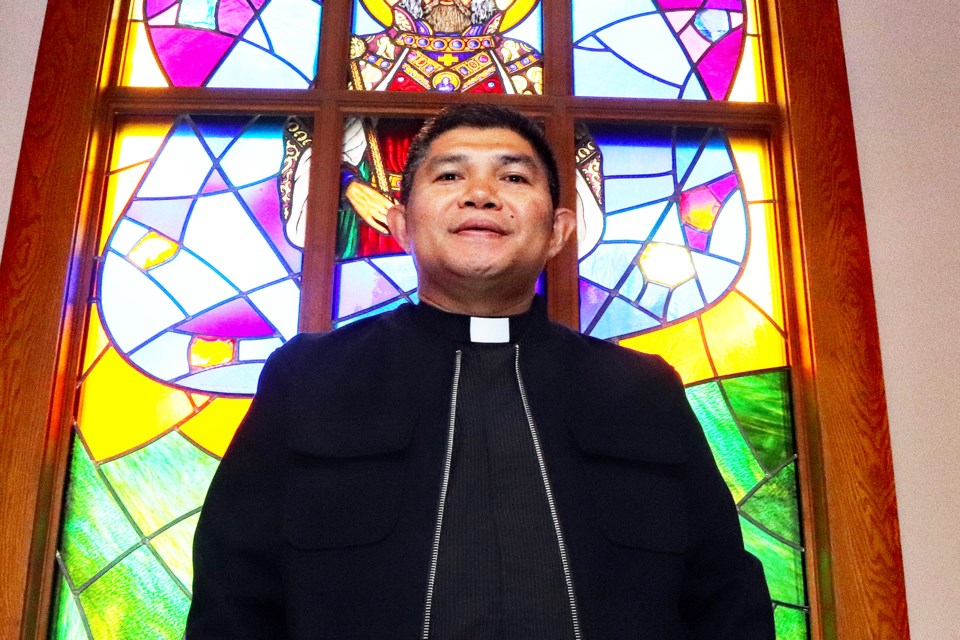OLDS – Father Nilo Macapinlac returned home last week after two days of following Pope Francis’s historic ‘penitential pilgrimage’ that included his long-awaited apology to Indigenous citizens on Canadian soil for the widespread abuse in the residential school system.
“I am sorry. I ask forgiveness, in particular, for the ways in which many members of the church and of religious communities co-operated, not least through their indifference, in projects of cultural destruction and forced assimilation promoted by the governments of that time, which culminated in the system of residential schools,” said the pope in Maskwacis on July 25, the first stop during his six days in Canada.
Macapinlac, the current priest at Olds’ St. Stephen's Catholic Church, was the parish priest at Maskwacis’ Our Lady of Seven Sorrows Catholic Church from 2013 to 2019.
He left Olds during the evening of July 24 for the pope’s visit to Maskwacis, 136 kilometres north of Olds and the former site of the Ermineskin Residential School, one of the largest residential school sites in Canada.
At least 15,000 Indigenous citizens attended in-person. Macapinlac said he was joined by two former Maskwacis parishioners to sit close enough to the pope to hear everything that was said, including the apology and the audience reaction.
“It was a beautiful celebration. They (audience) responded to the very moving words of apology from Pope Francis, and are looking forward to a deeper action,” said Macapinlac, who last week called his visit to Maskwacis a "homecoming."
“I think it was a helpful beginning, a first step of action towards collaboration.”
Macapinlac said he believes the pope’s apology will have a significant impact on all of Canada’s Indigenous people.
“There was an acceptance of the truth about abuse,” said Macapinlac. “That sheds light already on a tone because how can you reconcile if there is no acceptance? It is a very important fact that before we can reconcile there has to be an admission.”
What’s more, added Macapinlac, the apology is also significant for the Catholic church.
“Because the church, like a mother, will have to look after the needs of the crying babies and children. So, as a mother church we have to open our eyes and our ears to the sufferings and the pains of our people,” said Macapinlac. “So, as a mother who was already falling asleep at the middle of the night when the baby cries, he (the church) has to be sensitive to the needs of the baby.”
After his visit to Maskwacis, Macapinlac went to downtown Edmonton where the pope attended the Sacred Heart Church of the First Peoples to meet parishioners and Indigenous community members.
He was not able to get into the church but was able to reunite with people who went to the Vatican last April 1 and heard the pope’s first apology.
“I did not get in because of the high security and the pope had already started his liturgy so I was outside the fence but I was praying for its success and for whatever they needed to hear from the pope,” said Macapinlac.
The following day he went to Commonwealth Stadium where he joined 50,000 others for an open-air mass. He then headed to Lac Ste. Anne; a holy and sacred place to the people of Alexis Nakota Sioux Nation. It’s also a prominent site for the Métis community who settled there.
“It was amazing. And the drums were very, very strong to welcome the pope. He had a beautiful message, like a heartbeat of love. He blessed the waters of Lac Ste. Anne,” said Macapinlac.
“I saw it with my very own eyes. I was standing facing northeast, which they believe from 100 years ago some visionaries were able to see St. Anne, the grandmother of Jesus, walking on the water and brought a lot of healing, and in different forms.”
Following Lac Ste. Anne, the pope rested and journeyed to Quebec City the next day on July 27.
On July 29, the pope concluded his historic ‘penitential pilgrimage’ to Canada with a visit to Iqaluit to have a private meeting with former residential school students, and to attend a public event hosted by Inuit.
As for Macapinlac, he’s now taking a holiday but he plans to give testimony of the papal visit to Alberta to his Olds’ parishioners when he returns Aug. 14.



